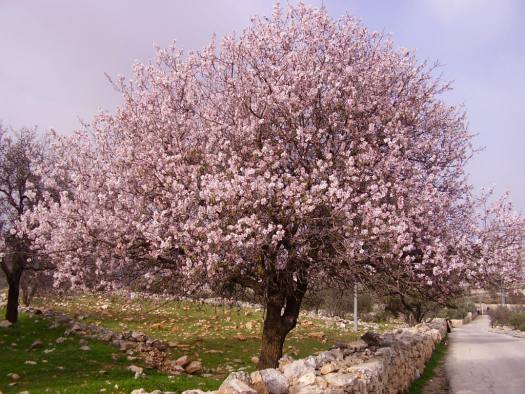Tu B'shvat
 Month of ShevatShevat is the name of a winter month in the Jewish lunar calendar.Tu is 15 Every letter in the Hebrew alphabet is also a number: T (tet) = 9 and U (vov) = 6. The “Bi” means “of ” or “ with”. Now you know how to decode the name. TuBiShvat is both a date and the name of a holiday celebrated on that date; it’s understood in the same way as the Fourth of July. About Tu B'ShevatAccording to Biblical law, there is a seven year agricultural cycle, concluding with the Sabbatical year..jpg) When the Holy Temple stood in Jerusalem, on years one, two, four and five of this cycle, farmers were required to separate a tenth of their produce and eat it in Jerusalem. This tithe is called Maaser Sheni, the Second Tithe, because it is in addition to the (two percent which must be given to the Kohain, and the) ten percent which is given to the Levite. On the third and sixth years of the cycle, instead of the owners eating the Maaser Sheni in Jerusalem, they gave this second tithe to the poor, who were permitted to consume it wherever they wished. It takes approximately four months for the rains of the new year to saturate the soil and trees, and produce fruit [On the Sabbatical year, no tithes are separated. All produce which grows during this year is ownerless and free for anyone to take.] It was therefore of vital importance to ascertain when the new year started for produce. Although this day is Rosh Hashanah for trees, we attach special significance to this holiday because "Man is [compared to] the tree of the field" (Deuteronomy 20:19). Through cultivating strong roots – faith and commitment to G‑d – we produce many fruits—Torah and Mitzvot. Trees are HolyJudaism has always seen trees as sacred. The Torah itself is called a “tree of life.”The Torah also forbids the cutting down of an enemy’s fruit trees, even in a time of war when the wood might be needed to attack a city. Caretakers Of The EarthIn the book of Genesis, humankind is instructed to be shomrei adamah, caretakers of the Earth, and of all God’s creations.Modern Tu B’Shevat CustomsThere are various minhagim (customs) associated with Tu B’Shevat, including:
Fulfillment in YeshuaJohn J. Parsons says it so beautiful on his site Hebrew 4 Christians.From the last page of his excelent Tu B'Shevat pdf file. Sign of the Almond TreeThe almond tree has special significance for Tu B’Shevat.The word for almond is shakeid which comes from shakad, a verb that means to “watch” or “wake.” The almond tree is the among the first trees to “awaken” from its winter sleep... We therefore eat almonds on Tu B’Shevat to celebrate the return of spring. In the Scriptures there is a play on words regarding the use of “almond” and God’s “watchfulness” (i.e., faithfulness): “And the word of the LORD came to me, saying, ‘Jeremiah, what do you see?’ And I said, ‘I see an almond branch. Then the LORD said to me, ‘You have seen well, for I am watching over my word to perform it’“ (Jer. 1:11-12).  The blooming branch of an almond tree is breathtakingly beautiful - so much so that the LORD decorated the Menorah with oil cups (i.e., gevi’im) in the shape of almond blossoms (Exod. 25:33-34; 37:19-20). Indeed , the Menorah itself is a symbol of the “Tree of Life” and therefore it is fitting to regard it during this season... Finally, some have said that Aaron’s rod - the staff he used to perform signs and wonders during the Exodus - was made from a branch of an almond tree.... Recall that during the incident of Korach’s rebellion, Aaron’s rod budded, flowered and produced almonds overnight (Num. 17), which was symbolic of the power of the “resurrected priest of God” that was coming... Just as God exclusively chose Aaron to minister before Him, so Yeshua was the exclusively chosen to be the greater High Priest of the New Covenant. Regarding His priesthood “after the order of Malki-Tzedek,” the author of Book of Hebrews wrote: “No one takes this honor for himself, but only when called by God, just as Aaron was” (Heb. 5:4). And just as Aaron’s lifeless rod miraculously brought forth life, Yeshua’s cross -- likewise made of wood -- also “budded and produced blossoms” after His resurrection from the dead. Yeshua went into the sanctuary made without hands and there offered his blood to procure for us an everlasting atonement. His sacrifice as our High Priest gives us life from the dead! Under the terms of the Sinai covenant, “Aaron’s rod” was a picture of God’s authority and judgment, just the Messiah’s cross and resurrection vindicates God’s exclusive choice of Yeshua as our Mediator before God. Those who reject His choice will ultimately share the same fate as those who partook of Korach’s rebellion (Jude 1:11). Yeshua (alone) is Adonai Tzidkenu, “the LORD our Righteousness” and Tzemach Tzaddik, God’s “Righteous Branch.” Praise His Name forever. |
| (c) EWCMI 2009-2025 | Terms of Use | ||
| All Donations, Seeds, and Tithes to Eagle Wings Charismatic Ministries International are tax deductible per the Internal Revenue Code 501(c)(3) Public Charity Status 170(b)(1)(A)(i) DLN 17053243329039 | |||
 |
|||






